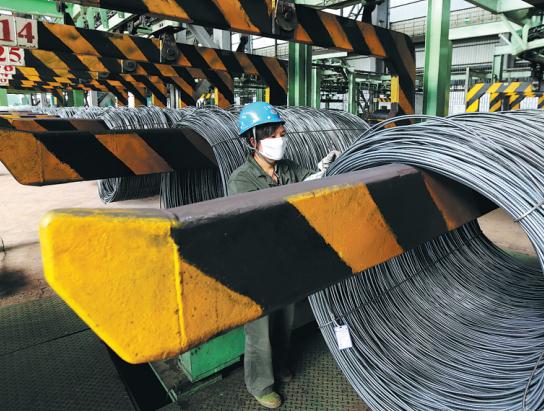The year of the great turnaround


China's steel industry shines again on capacity cuts in 2017 and better quality
China's steel industry notched up a creditable achievement last year. It improved product quality, which helped increase prices and boosted companies' financial performance. All this was made possible by rigorous capacity cuts, in response to the government's call to the sector to deal with overcapacity, rationalize and modernize.
Shanghai benchmark steel rebar prices gained more than 50 percent last year, hitting 5,230 yuan ($815) per metric ton on Dec 5, the highest level since August 2008, according to steel trading platform Xiben New Line E-Commerce.
Steel prices soared on expectations that supply would tighten due to capacity cuts.
The country had met its target of cutting steel capacity by 50 million tons by last August by phasing out substandard steel bars and closing zombie companies, according to the National Bureau of Statistics.
"In the last two years, China has slashed its steel capacity by 115 million tons, close to the upper limit of 150 million tons it has set during the 13th Five-Year Plan period (2016-20)," said Xu Wenli, head of the iron and steel division at the Ministry of Industry and Information Technology.
China will further cut outdated steel capacity and prevent shuttered or illegal steel mills from returning to the market in 2018, he said.
The country will not allow any increase in its iron and steel capacity this year, according to an MIIT statement on Jan 3.
The steel sector should focus on improving the quality of its products and create more mid- to high-end products this year, said the statement.
China will further its supply-side structural reform this year, with more efforts to improve economic quality, promote innovation, cut overcapacity and foster new growth drivers, said a statement released after the annual Central Economic Work Conference in December 2017.
To help local governments achieve their capacity cut target, the Ministry of Finance in May 2017 gave additional rewards to nine local governments that have exceeded their capacity cut targets.
In 2016, the central government allocated a total of 100 billion yuan to help local authorities and State-owned enterprises finance layoffs in the coal and steel sectors.
Crackdown on substandard steel also helped the sector's healthy development.
Early last year, the National Development and Reform Commission, the country's top economic regulator, set a timeline to phase out production of low-quality steel made from scrap metal before the end of June 2017.
More than 600 steel mills engaged in the production of substandard steel products were closed by last October, with combined capacity reaching 140 million tons, according to the NBS.
Authorities sent 12 inspection groups to areas including Hebei, Henan and Heilongjiang provinces and the Guangxi Zhuang autonomous region to oversee the move.
"The capacity cuts and exit of substandard steel products have injected new vitality into the bloated steel sector, through creating a more standardized market order and pushing legal enterprises to speed up production," said Wang Guoqing, research director at the Lange Steel Information Research Center.
In the first 11 months of 2017, the country's crude steel production went up 5.7 percent year-on-year to 764.8 million tons, according to the NDRC.
China's crude steel output was expected to increase by 3 percent year-on-year to 832 million tons in 2017, and by a further 0.7 percent to 838 million tons this year, according to a report from the China Metallurgical Industry Planning and Research Institute.
"The country's ongoing environmental protection checks have also reduced steel inventory and thus further driven up steel prices," Wang said.
The Ministry of Environmental Protection has required steel mills in some heavily polluted northern cities, including Shijiazhuang, Tangshan, Handan and Anyang, to reduce steel production capacity by 50 percent during the heating season from November 2017 to March this year.
Some other cities surrounding Beijing were also ordered to cut the production capacity by different percentages to ensure good air quality.
"This move has reduced the steel inventory by 14 percent to 6.79 million tons in 29 major steel production cities," said Wang.
"All these favorable policies have led to booming profits at Chinese steel mills," she added.
In the January-November period last year, combined net profits in the ferrous metal smelting and rolling sector surged 180 percent year-on-year to 313.88 billion yuan, according to the MIIT.
In the first 11 months of 2017, members of the China Iron and Steel Association saw their profits surge 360 percent to 157.8 billion yuan, with profit margins reaching 4.7 percent, up 3.2 percentage point year-on-year, Xinhua reported.
China Baowu Steel Group, the nation's largest steelmaker, reported a 66.6 percent increase in net profit to 14.56 billion yuan during the January to October period of 2017 due to high steel prices.
Its revenue was up by 55.4 percent year-on-year to 388.8 billion yuan during the same period, showing the benefits of integration and the deepening of State-owned enterprise reform, according to the company.
As Chinese steel producers achieve more technology breakthroughs and produce more high-end products to meet domestic needs, China is also seeing a decline in the country's steel imports, Wang said.
"Although great achievement has been made in the steel sector in 2017, there is still room for improvement," said Li Xinchuang, president of the China Metallurgical Industry Planning and Research Institute.
The profit margin of steel enterprises is still lower than the average figure for the industrial sector, and more than 10 percent of steel companies still suffered losses last year, Li said.
The sector still faces great pressure of deleveraging as its debt ratio currently stands at almost 70 percent, much higher than the 55 percent average for the industrial sector, he said.
"We should view their profit growth in an objective way as the sector needs reasonable profits to push for technological innovation, increase investment in environment protection as well as ensure employee welfare," Li said.





































